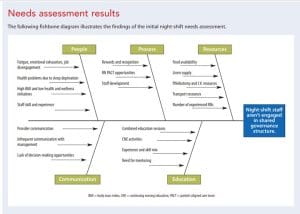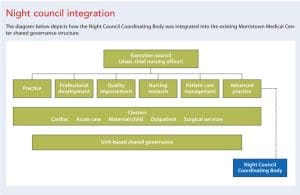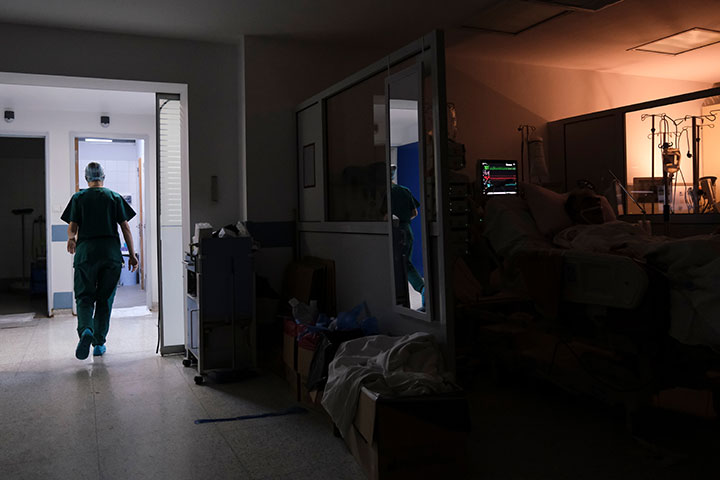Bring night-shift nurses to the shared governance table.
Takeaways:
- Night-shift nurses frequently miss out on the benefits of shared governance and are left out of decisions because most system-wide and unit-based council meetings take place during the day.
- Recognizing this issue, a New Jersey hospital established a night-shift shared governance council.
- Results of the work of the night-shift council include an I.V. resource team, a journal club, and improved provider communication.
Nursing shared governance facilitates structural empowerment—a key component of the American Nurses Credentialing Center Magnet Recognition Program® model. However, the accountability, equity, and decision-making power encouraged by shared governance frequently doesn’t reach night-shift nurses because most system-wide and unit-based council meetings take place during the day. Competing demands, such as school or family obligations, make it difficult for these nurses to participate in activities and meetings during the day. Night-shift nurses know that they’re sometimes left out of decisions simply because they’re not at the table.
Morristown Medical Center (MMC), which received Magnet recognition 5 consecutive years, struggled with this situation, too. In 2017, acknowledging the need to support night-shift nurses, MMC established dedicated night educator positions to address nurses’ learning requirements. Since then, the need to expand shared governance engagement to the night shift became more evident. Two dedicated educators championed the idea of forming a night-shift shared governance council. They solicited feedback from nurses, attended a national nursing conference where they benchmarked with other organizations across the country to learn more about night council development, and distributed focus group surveys to night-shift nurses to gauge interest. They also conducted a literature search for existing night-shift shared governance processes but found few articles on the topic.
The concept of a night-shift shared governance council isn’t new, and despite attempts by many organizations to develop them, sustaining interest and participation can be difficult.
Assessing the need
According to Blackstone and colleagues, the University of Virginia Health System, a Magnet-designated organization, identified lack of visible leadership and professional development opportunities as contributing factors to inequality between day-shift and night-shift nurses. Murray and colleagues reported that, at another organization, most committee meetings, celebrations, and clinical ladder progression opportunities occurred during day-shift hours, leading to disengagement and dissatisfaction among night-shift staff.
MMC’s December 2019 needs assessment survey found lack of professional development opportunities as the top reason for decreased night staff engagement in the clinical ladder program. In January 2020, four discussions (with 12 to 15 nurses each from various care units) identified several additional needs, including improved off-shift provider communication, patient transport resources after 11 pm, weekend supply availability, education and resources for new staff, professional advancement opportunities at night, and limited food choices in the cafeteria. (See Needs assessment results.)


Creating a structure
As a result of the COVID-19 pandemic, work to create a night shared governance council (Night Council Coordinating Body) began on October 1, 2020, with the first virtual planning meeting. The council’s purpose includes providing clinical leadership and practice guidance via education, research, collaborative practice, and peer review during off-shift hours. It promotes and empowers nurses to be engaged leaders within their own practice, fosters collaboration among different units and interprofessional partners, and identifies areas for improvement and solutions.
The council’s chair created the bylaws, which were reviewed by the MMC shared governance and Magnet program director. Council members include the off-shift manager, shared governance manager, intensive care unit outreach/rapid response nurse, pharmacist, a unit educator, an assistant nurse manager, and nurses from various settings (medical-surgical, critical care, cardiac, and pediatric). As needed, council leadership invites experts from other patient care disciplines to serve as ad hoc members. Currently, the council has 42 members.
The council reports to the executive council and provides clinical recommendations to improve care quality and integrate the scope of practice and standards of care within specialty clinical areas. It uses the shared governance issue form to report and escalate any patient care or practice concerns to the corresponding hospital-wide shared governance council or practice area. (See Night council integration.)


Night Council Coordinating Body activity outcomes are shared with its members every quarter. Starting in 2022, the executive council has received outcome data during the annual shared governance retreat.
Goals and outcomes
After the second COVID-19 surge, council members agreed to focus on three main goals for 2021—improving provider communication, developing an I.V. resource team, and creating a journal club—based on a needs assessment, discussions, and organizational strategic requirements.
Provider communication
The Night Council Coordinating Body chair and a member from the medical unit created discussion questions to identify communication challenges and develop strategies for improvement. The council chair presented their findings and recommendations to the executive council. The advanced practice night (APN) off-shift providers then worked with the Night Council Coordinating Body to create a communication plan that includes roles and responsibilities and appropriate use of communication channels to enhance patient care.
Outcomes: The provider communication project has been a success. The APN providers participate in council meetings and night-shift staff report improved communication.
I.V. resource team
To facilitate peripheral I.V. education and address difficult insertions, one of the dedicated nurse educators launched a pilot team. In December 2020, the night council applied for an internal grant for a vein viewer device. The council received the device in May 2021 and trained a preselected group of staff to use it.
Outcomes: Currently, 14 night-shift nurses are trained to use the vein viewer device to aid difficult I.V. insertion. In 2021, the I.V. resource team conducted four training sessions and conducted 126 insertions. In 2022, they facilitated three training sessions and as of June had performed 205 insertions. The team is working on an on-call process for easy unit accessibility.
Journal club
A medical-surgical nurse spearheaded the launch of a night-shift journal club, which encourages and promotes professional development among night-shift nursing staff to facilitate quality care, achieve personal and professional satisfaction, improve morale, and advance careers. The council aimed to offer at least four night-shift journal club articles with continuing nurse education (CNE) credits.
Outcomes: In 2021, the journal club presented four articles with CNE credits. Based on one of the articles, the Night Council Coordinating Body is working with the Quiet at Night committee on a project to improve patient sleep scores.
Future goals
The Night Council Coordinating Body has deployed several strategies—monthly meetings to discuss current issues, yearly surveys, and steps for improving attendance from other disciplines—to ensure it remains productive and engages all staff. Monthly meetings held virtually and in-person as circumstances allow provide the flexibility to keep members engaged. End-of-year surveys distributed to all night-shift staff assess their current learning needs, provide insight into the impact of council activites, and identify night-shift issues that require council discussion.
Results of the December 2021 survey indicated that the I.V. resource team and availability of more clinical ladder opportunities had the most impact on the night shift. The survey also helped establish 2022 goals, including maintaining and growing the I.V. resource team, holding quarterly journal clubs, initiating monthly coffee nights, and increasing night-shift clinical ladder engagement. Other 2022 goals include care delivery, effective care team communication, and availability of resources to support night-shift staff well-being. Night-shift team member participation in identifying challenges and problem solving gives them a voice in improving the care they provide.
Disseminating outcomes and information at system-wide meetings allows other sites to understand the council’s value and how establishing a night council within their organization might improve structural empowerment. After informal communication on a listserv, the Night Council Coordinating Body received several inquiries from nurse educators and leaders. The council hopes to disseminate more information about its processes and outcomes in publications and presentations.
With leadership support, the MMC Night Council Coordinating Body will continue to grow along with increased interest, participation, and interprofessional collaboration.
The authors work at Morristown Medical Center in Morristown, New Jersey. Jolly Varughese Thomas is a nurse educator. Wendy Silverstein is nurse manager of shared governance, nursing education, and Magnet. Lauren Stroh is a nurse educator.
References
American Nurses Credentialing Center. 2023 Magnet® Application Manual. Silver Spring, MD: ANA Enterprise; 2021.
Blackstone K, Wade A, Horn J. Satisfying, engaging, and empowering night-shift clinicians through shared governance: A night-shift committee focuses on employees’ needs. Am Nurse Today. 2019;14(5):48-54.
Kroning M, Hopkins K. Healthcare organizations thrive with shared governance. Nurs Manage. 2019;50(5):13-5. doi:10.1097/01.NUMA.0000557781.40049.2d
Murray K, Schmidt K, Goodyear C. Navigating night-shift nuances. Nurs Manage. 2018;49(10):44-8. doi:10.1097/01.NUMA.0000546203.40080.88
Winks D, Weaver SH, Adona-Catiis M, et al. Shared governance at night. Nurs Manage. 2017;48(3):18-21. doi:10.1097/01.NUMA.0000512896.91295.9e
Key words: Night shift nurses, shared governance, Magnet, unit-based councils



















3 Comments. Leave new
I am a night shift supervisor and I would love to support a night shift shared governance council. We do have some IV start difficulties. The staff calls either me or our clinical educator for IVs at night. I already know of a few other issues for example, how to handle difficult patients at night. I believe we need training for self-defense. One other example is the bottleneck in capacity management that occurs around 4 p.m. to 10 p.m. This bottleneck creates multiple change of shift admissions from ED, feeder facilities, cath lab, and Direct Admits which could be diminished with earlier decompression of ED and resources such as EVS et transport. Any thoughts on these situations?
I am so happy to see changes like this. The night shift is frequently left out of communications and plans. This is a great way to form an inclusive and representative organization! It also minimizes the “us versus them” mindset that can arise between the two shifts.
Great job! I’m an AHS employee more than 20 years and have worked all shifts. Can totally relate to everything discussed.